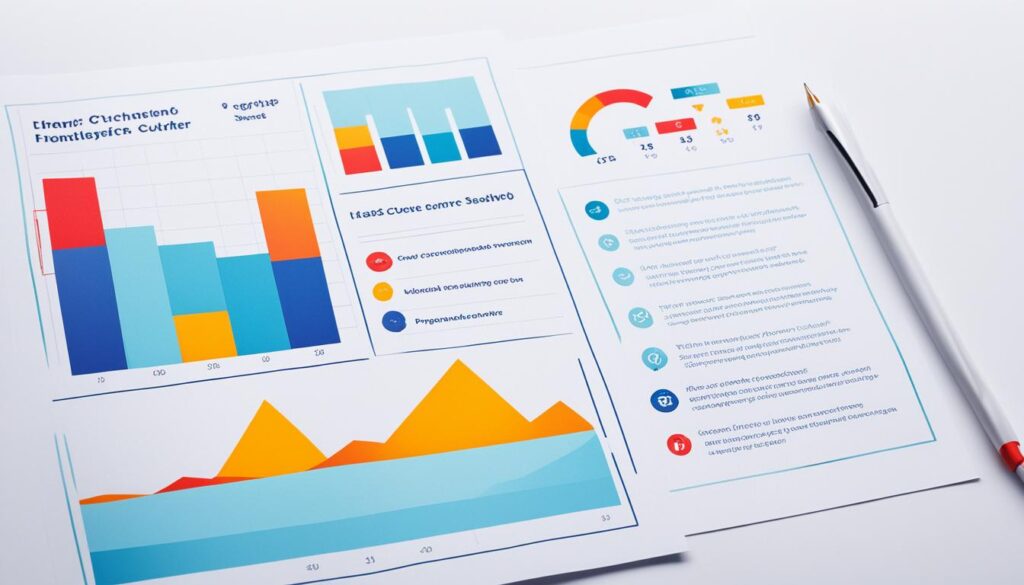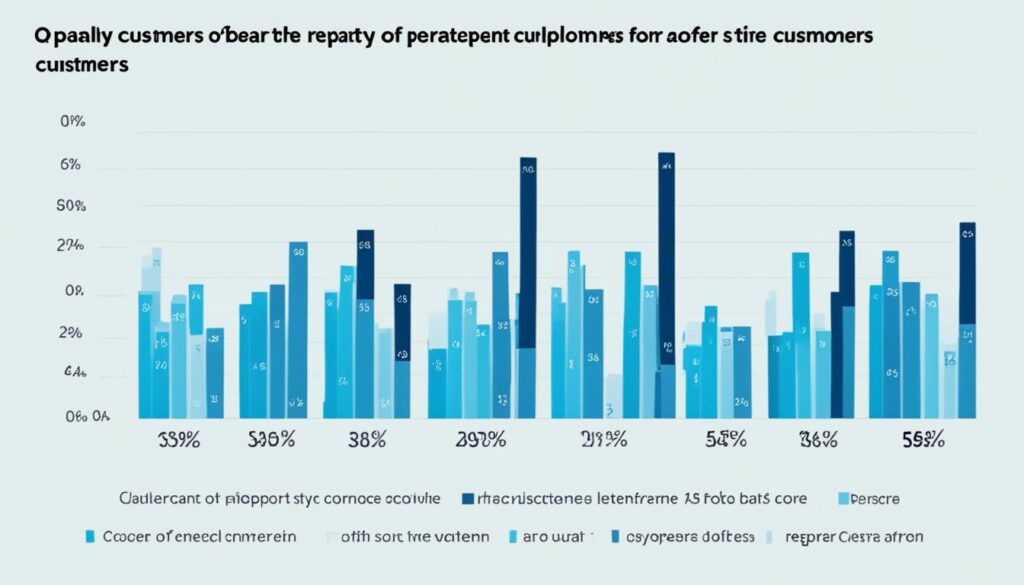Loyalty programs are a key way for businesses to keep their customers coming back. They offer rewards for repeat purchases. This can boost how happy customers are and improve sales overall. This article will cover the steps to set up a loyalty program that keeps customers and helps your business grow.
Key Takeaways:
- Create a customer loyalty program to attract and retain loyal customers
- Implement incentives to encourage repeat purchases and increase customer satisfaction
- Follow the steps outlined in this article to create a successful program that drives customer retention
- By effectively managing a customer loyalty program, businesses can boost their bottom line
- Customer loyalty programs are a valuable tool for businesses looking to enhance customer relationships and drive growth
Benefits of a Customer Loyalty Program
Customer loyalty programs offer many pluses for companies. They help in growing and finding success. Such programs make customers want to buy again. This boosts customer loyalty, happiness, and their desire to stay with the brand. Effective loyalty programs can also earn more sales by making customers spend more and bring in new customers. Let’s look at these advantages closely.
1. Enhanced Customer Retention
Loyalty programs are key to keeping customers around. They reward loyal customers with perks and discounts. This encouragement makes them want to stay with the brand. Such customers also tend to recommend the brand to others. This boosts loyalty, reduces lost customers, and strengthens the customer-brand relationship.
2. Increased Revenue through Repeat Business
The main goal of loyalty programs is to get customers to buy again. By giving out points, discounts, or free items, a brand can beat competitors. This leads to more sales. Plus, loyal customers might try more products, spending even more. This way, businesses see more money coming in.
3. Positive Customer Experiences and Satisfaction
Loyalty programs make customers happy by offering personalized rewards. Also, they give access to new products before others. There are VIP events and special customer support too. These extras make customers feel special and happy. This builds strong loyalty and long-lasting relationships.
4. Word-of-Mouth Referrals and Brand Advocacy
Satisfied customers often talk positively about the brand to others. They share their good experiences via word of mouth. Such recommendations have a big impact on other people’s buying decisions. This brings in more customers. Happy customers, in a way, market the brand themselves by recommending it to others.
| Loyalty Program Benefits | Customer Retention | Repeat Business | Increased Revenue |
|---|---|---|---|
| Enhanced Customer Retention | Incentivizes customers to remain loyal to the brand. | Encourages customers to make repeat purchases. | Results in higher sales and customer spend. |
| Increased Revenue through Repeat Business | Fosters consistent engagement and customer spend. | Drives higher transaction values. | Contributes to overall revenue growth. |
| Positive Customer Experiences and Satisfaction | Creates a sense of value and appreciation. | Enhances overall customer satisfaction. | Builds long-term customer relationships. |
| Word-of-Mouth Referrals and Brand Advocacy | Generates recommendations to others. | Expands the customer base through referrals. | Increases brand awareness and credibility. |
Implementing a loyalty program can boost customer relationships and lead to more business. It also means more revenue and growth for the company.
How to Build Customer Loyalty
Building customer loyalty needs a wide-reaching plan. It should focus on making the customer happy beyond just buying. Let’s look at some effective tactics to keep customers coming back.
- Adopt a Multi-Channel Customer Service System: In today’s world, customers want to be able to reach out in many ways. So, having various touchpoints like phone, email, chat, and social media is a must. This makes you more available and gives top-notch service.
- Deliver Exceptional Service: Offering great service is key to keeping customers. Aim to surprise them by understanding their needs, solving problems quickly, and adding more than expected. Always strive to offer the best in products and services.
- Build Credibility through Meaningful Interactions: Trust and loyalty grow from real conversations. Listen to what customers say, suggest things just for them, and provide helpful info. These interactions make their experience better.
- Deliver Added Value Beyond Transactions: Find ways to give more to your customers. Whether it’s useful info, special deals, rewards, or tips picked just for them, going the extra mile is noticed and appreciated.
- Share Positive Customer Experiences: Happy customers sharing their experiences is very powerful. Urge them to talk about the good things they’ve experienced with your brand. This can be through reviews, testimonials, or social media. It builds trust and draws in more clients.
- Implement a Reward System: Giving back to loyal customers is a great way to encourage them to stay. Think about a program that rewards them uniquely, like with discounts or exclusive offers. Loyalty should feel valued and fruitful.

By using these measures, companies can make customers more loyal. They will have a better experience with your brand, leading to more success in the long run.
What is a Customer Loyalty Program?
A customer loyalty program is a way for businesses to reward customers who keep coming back. It gives people a reason to choose one business over others. Rewards might include free items, access to special events, or discounts.
These programs help companies keep customers happy and coming back. It’s a way to say “thank you” for choosing their business.
Key Features of a Customer Loyalty Program:
- Rewards for continuous purchases
- Exclusive access to events
- Discounts on future purchases
- Point systems
- Free products or services
Benefits of a Customer Loyalty Program:
Customer loyalty programs offer great perks for businesses:
- Keep customers coming back
- Make customers happier
- Get customers more involved
- Encourage repeat business
- Build strong loyalty
For businesses, loyalty programs mean customers return, and loyalty grows. Customers enjoy benefits and feel valued. It’s a great deal for everyone involved.
Case Study: XYZ Coffee Shop’s Loyalty Program
“Our loyalty program has changed everything. We’ve kept more customers, and they love what we offer. This has made our customer bonds stronger and our community more loyal to our brand.”
The XYZ Coffee Shop loyalty program, for example, gives a free coffee after 10 purchases. It also includes invites to special tasting events. This has attracted more customers and increased satisfaction.
Loyalty programs help businesses strengthen ties with customers, encourage more visits, and build loyal followings.
| Rewards | Benefits |
|---|---|
| Free products | Customer appreciation |
| Exclusive access to events | Enhanced customer satisfaction |
| Discounts on future purchases | Incentivized repeat purchases |
| Point systems | Increased customer loyalty |
Loyalty programs acknowledge and reward customers’ loyalty. They make business better for both the company and its customers.
How to Create a Customer Loyalty Program
To start a customer loyalty program, focus on what your customers want and need. Pick rewards they will love, track their rewards well, and tell them about the program clearly. This way, you engage and keep your customers loyal.
Step 1: Assess Customer Needs
Start by figuring out what your customers care about. Look at what they buy, what they like, and what keeps them coming back. Use surveys and sales data to understand their needs.
Step 2: Choose Rewards
Choose rewards that your customers will be excited about. This can be discounts, early access to new items, free gifts, or points. Make sure the rewards are something your customers aim to get.
Step 3: Implement a Tracking System
Setting up a way to track who’s taking part and what they’re getting is key. This helps you understand how well your program is doing. You can use software to see who’s using the program and how often.
Step 4: Communicate and Promote
Make sure your customers know about your loyalty program. Use your website, social media, emails, and signs to spread the word. Remind them often and let them know about special deals.
Step 5: Regularly Evaluate and Adjust
Keep an eye on how your program is doing and make it better when you can. Listen to what your customers have to say. Change your rewards or how you let people know about your program to make it more popular.
Follow these steps to make a successful loyalty program. It will keep your customers happy and wanting more. A good loyalty program can really help your business grow.

Customer Loyalty Programs for Small Businesses
Loyalty programs are a great tool for small businesses. They help keep customers coming back and attract new ones. By making their experience personal, offering special deals, and giving them invites to special events, businesses can really make their customers feel valued.
To stand out from other companies, focusing on community building is smart. This means making customers feel like they belong. It helps small businesses keep their customers coming back, instead of going to the competition.
Customizing rewards and experiences is also important. Knowing what a customer likes and using that to make them feel extra special can go a long way. It helps keep them happy and wanting to come back again and again.
Creating a community around your business is a solid move too. Hosting events just for your most loyal customers can be a great way for them to meet each other and bond with your brand. This way, they’re not just loyal, they’re also likely to tell others about you.
In conclusion, loyalty programs fit small businesses well. They offer a way to retain and grow their customer base. By choosing strategies that are not too expensive and that focus on personalization, businesses can turn their customers into their best marketers.
| Benefits of Loyalty Programs for Small Businesses | Strategies |
|---|---|
| 1. Increased customer retention | – Personalized experiences |
| 2. Higher customer satisfaction | – Special discounts |
| 3. Growth through customer advocacy | – Exclusive access to events |
| – Community-building efforts |
Study Your Current Customers
Before starting a customer loyalty program, businesses should know their current customers well. They must look at customer behavior, who spends the most, and what makes them happy. This helps businesses create a loyalty program that really works for their customers.
Paying attention to what customers buy can guide businesses. They can see which products or services are popular. Then, they can offer special rewards on these items, appealing to their customers’ taste.
It’s also important to group customers by their interests or buying habits. Doing this helps businesses make different loyalty program levels. So, each customer group gets rewards that fit them best.
Figuring out which customers bring in the most money is key. Businesses can then focus on keeping these top customers happy. This boosts their loyalty and leads to more sales.
To make a loyalty program that really works, businesses need to know what customers think. They should talk to customers to learn what they like and where they want to see change. This ensures the loyalty program meets their expectations.
Example:
“Our study revealed that many customers love eco-friendly products. So, we started a loyalty program that offers deals on these items. It’s made our customers happier and they keep coming back.”
Studying current customers closely can lead to a successful loyalty program. Knowing their habits, who they are, and what they like is crucial. This way, the loyalty program will be a hit, making customers more happy and loyal.
| Data | Key Insights |
|---|---|
| Customer Behavior | Identify purchasing patterns and preferences to offer targeted rewards |
| Customer Segmentation | Create loyalty program tiers or personalized experiences for different customer segments |
| Customer Profitability | Reward and engage with the most valuable customers to enhance their loyalty |
| Customer Satisfaction | Gather feedback to identify pain points, preferences, and areas for improvement |
Set Goals and Measure Success with CRM
Clear goals are key for any successful customer loyalty program. Setting objectives helps businesses know where to go. It helps them focus on boosting customer loyalty, happiness, and sales.
Measuring success is easier with CRM software. It tracks customer data, interactions, and purchases. This data is then analyzed. It offers insights that guide better program decisions.

The Benefits of Using CRM for Loyalty Program Measurement
CRM software gives a detailed look at customer relationships. It helps businesses understand what customers like and how they use loyalty programs. By using this data, businesses can do several things:
- See what customers buy and when to spot trends
- Understand how involved customers are in the loyalty program
- Differentiate customers based on their loyalty patterns
- Check how happy and loyal customers are
This knowledge lets companies check their loyalty program’s success. They compare data before and after to see if they’re doing better.
Using CRM Data to Optimize Loyalty Programs
CRM data is valuable for more than just measuring success. It offers tips on what to do next. Companies can:
- Find the best customer groups for the program and focus on them
- Change rewards and program details to fit what customers like
- Send personal messages and deals to make customers more involved
- Suggest new items to buy based on what customers have bought before
By using CRM data, companies keep their loyalty programs fresh and successful. They drive loyalty and keep customers happy.
Key Metrics for Measuring Loyalty Program Success
| Metric | Description |
|---|---|
| Customer Retention Rate | The percentage of customers who continue to make purchases and remain loyal to the business |
| Repeat Purchase Rate | The percentage of customers who make repeat purchases within a defined period |
| Program Engagement | The level of customer participation and interaction with the loyalty program |
| Customer Satisfaction Score | A measure of customer satisfaction and perceived value derived from the loyalty program |
Choose Tactics to Encourage Customer Loyalty
Businesses can do a lot to keep their customers coming back. They can use many smart strategies in their loyalty programs. These methods can really boost how much customers interact and stay loyal over time. Here are some fantastic strategies to try out:
1. Personalized Offers
Making deals just for a customer based on what they like and buy can really make them feel special. It also makes them more likely to buy from you again. When businesses offer deals that match what their customers love, it can really increase their loyalty and interest.
2. Exclusive Experiences
Offering events or early product access to loyal customers can make them feel like part of a special group. It makes them want to stick with the brand. Things like VIP events, chances to see new products first, or special membership-only perks can do wonders for keeping customers loyal and engaged.
3. Gamification
Making loyalty programs feel like a game can be really fun and engaging for customers. By adding challenges, rewards, and badges for milestones, it makes the whole experience more enjoyable. This setup encourages customers to keep at it because they’re having a good time.
4. Referral Programs
Having customers bring their friends in can really grow your base and keep current customers coming back. By giving a little something to customers who tell others about their positive experiences, you’re able to reach new people and make them loyal too. The power of word-of-mouth in action.
5. Surprise Rewards
Everyone loves a surprise. Adding extra rewards or offers out of the blue can really jazz up a loyalty program. It keeps things fresh and creates strong, positive connections with the brand. These unexpected treats can make customers feel truly valued.
When businesses use a mix of these strategies and adjust them to fit the preferences of their customer base, they can craft a loyalty program that works wonders. It keeps customers interested, loyal, and has a positive effect on business growth.
| Tactic | Benefits |
|---|---|
| Personalized Offers | – Enhanced customer engagement – Increased repeat purchases – Higher customer satisfaction |
| Exclusive Experiences | – Cultivates a sense of exclusivity – Boosts customer loyalty – Encourages active program participation |
| Gamification | – Enhances program interactivity – Motivates continued engagement – Makes loyalty fun and rewarding |
| Referral Programs | – Expands customer base – Drives customer acquisition – Capitalizes on positive word-of-mouth |
| Surprise Rewards | – Creates delightful customer experiences – Strengthens emotional connection – Generates positive brand associations |
Measure the Success of Your Loyalty Program
Measuring your loyalty program’s success is key once it’s running. By checking key numbers, you see how well it keeps customers. This helps you make smart choices to do better.
Key Metrics to Consider
There are some main things to look at when you want to know if your program is working:
- Customer Retention Rates: Shows what percent of customers keep coming back. High rates mean your program is making customers stick with your brand.
- Repeat Purchase Rates: How often customers buy from you again is important. If this number is high, your program is working well.
- Program Engagement Levels: This looks at how much your customers take part in the program. High engagement tells you they like and use your program a lot.
Using CRM Software for Tracking
CRM software can help lots with keeping an eye on these numbers. It lets you look at how customers act and buy. Connecting this data with your loyalty program info helps improve how you keep customers coming back.
Regular Monitoring and Analysis
It’s important to always check how your loyalty program is doing. This way, you can see what needs fixing and make things better. Looking at the numbers often helps you spot trends and new chances to grow.

Checking up on your loyalty program’s success is a must. By watching customer return rates, how often they buy again, and how much they use your program, you get key insights. These insights can help you upgrade your program to have more effect.
Implementing a Successful Loyalty Program
Creating a winning loyalty program takes careful planning and dedication. A strong communication strategy is crucial. It should clearly show customers the benefits they’ll get. Use social media, emails, and signs in your store to get the word out and build excitement.
Employee training is also key. They need to know the program well. This ensures they provide great service and keep the message consistent. This, in turn, improves how customers view your program and boosts their loyalty.
To make your program a hit, you’ve got to promote it well. Spread the word using various means to catch many eyes. Social media is great for this, as it lets you talk directly to customers. Also, use emails to let them know about special deals.
Listening to what customers say is critical. Ask for their thoughts often. This feedback can show you how to make your program even better. Use surveys or social media to hear from them.
Benefits of Effective Communication Strategy:
- Increased program awareness and participation
- Enhanced customer engagement and loyalty
- Higher customer satisfaction levels
- Improved customer retention and repeat business
“A well-designed communication strategy not only informs customers about the loyalty program but also creates enthusiasm and excitement, driving higher engagement and participation.”
Employee Training:
- Educate employees about the program’s benefits and features
- Ensure consistent messaging and customer service
- Empower employees to promote the program in their interactions with customers
“Well-trained employees who understand the program can effectively communicate its value to customers, increasing program engagement and overall customer satisfaction.”
By focusing on good communication, training your team well, and listening to customers, your loyalty program can succeed. Doing these things boosts how well the program is received and keeps customers coming back.
Conclusion
Starting a customer loyalty program is smart for businesses wanting to improve ties with their customers. By following the steps we talked about, your business can create a program that really values its customers. This can lead to happier customers, more customers returning, and more money being spent with you.
A good loyalty program does more than just keep customers around. It also gets them to spend more and feel closer to your brand. When you reward them for coming back and make their experiences special, you build a strong bond with them. This brings a lot of benefits for your business, including more money and better interactions with your customers.
To make sure your loyalty program works, you need to have clear goals, keep track of how it’s doing, and always check its impact. Using customer data, you can see what’s working and what’s not. This helps you make changes that keep your customers happy and coming back.
Putting in a solid loyalty program that enhances the way customers see your business and thanks them for their loyalty can really help your business grow. It sets up your business for success in the long run.
FAQ
What are the benefits of a customer loyalty program?
Loyalty programs help keep customers coming back. They make customers happier and grow revenue. This happens through more sales and new customers from good word of mouth.
How can businesses build customer loyalty?
Offering great customer service can make a big difference. So does always delivering top-quality products and experiences. Also, don’t forget to give back to your loyal customers. Gift them with rewards for sticking around.
What is a customer loyalty program?
It’s a way for businesses to say thank you to their regular customers. It rewards them for coming back and buying more. This builds a strong bond between the customer and the business.
How do you create a customer loyalty program?
First, look at what your customers really want. Then, pick rewards that match those wants. Make sure you can track who gets what. Finally, let everyone know what goodies they can get by shopping more with you.
Are customer loyalty programs beneficial for small businesses?
They can be a game-changer for small ventures. Special perks like personal shopping experiences or limited discounts make customers feel valued. This can work better than big ad campaigns.
How should businesses study their current customers?
By looking closely at who buys what and why, you can see what makes them happy. This info helps you dish out rewards and deals that they really care about. You can use this understanding to make your loyalty program stand out.
How can businesses set goals and measure the success of their loyalty programs?
Start with clear goals like having more repeat buyers. Using tech tools, you can keep an eye on who’s sticking with you and why. This way, you know if your plan is working.
What tactics can businesses use to encourage customer loyalty?
Make your customers feel special with unique deals or invites to cool events. Add fun games they can win or introduce a way for them to bring in their friends. Surprising them with unexpected bonuses also goes a long way.
What metrics should businesses use to measure the success of their loyalty programs?
It’s all about how many people keep coming back, buy again, or are actively engaged in the program. Tech tools like CRM systems help keep track of these key numbers.
How should businesses implement a successful loyalty program?
Spread the word clearly and often. Train your team to support it. Always listen to what your customers say about it. Review and tweak regularly to keep it fresh and effective.


















